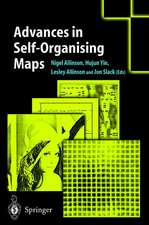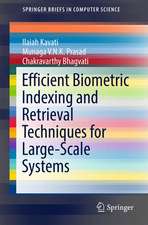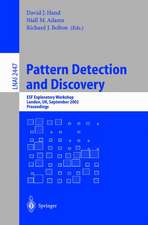Human Ear Recognition by Computer: Advances in Computer Vision and Pattern Recognition
Autor Bir Bhanu, Hui Chenen Limba Engleză Hardback – 25 iun 2008
This book explores all aspects of 3D ear recognition: representation, detection, recognition, indexing and performance prediction. It uses large datasets to quantify and compare the performance of various techniques.
Features and topics include: Ear detection and recognition in 2D image - 3D object recognition and 3D biometrics - 3D ear recognition - Performance comparison and prediction.
The techniques discussed will be of great interest to researchers, developers and decision makers who are involved in robust human recognition by computer for a large number of practical applications.
| Toate formatele și edițiile | Preț | Express |
|---|---|---|
| Paperback (1) | 641.67 lei 43-57 zile | |
| SPRINGER LONDON – 21 oct 2010 | 641.67 lei 43-57 zile | |
| Hardback (1) | 644.81 lei 43-57 zile | |
| SPRINGER LONDON – 25 iun 2008 | 644.81 lei 43-57 zile |
Din seria Advances in Computer Vision and Pattern Recognition
- 20%
 Preț: 998.36 lei
Preț: 998.36 lei - 20%
 Preț: 409.80 lei
Preț: 409.80 lei - 20%
 Preț: 654.70 lei
Preț: 654.70 lei - 20%
 Preț: 775.30 lei
Preț: 775.30 lei - 20%
 Preț: 867.15 lei
Preț: 867.15 lei - 20%
 Preț: 241.87 lei
Preț: 241.87 lei - 20%
 Preț: 659.83 lei
Preț: 659.83 lei - 20%
 Preț: 1084.17 lei
Preț: 1084.17 lei - 20%
 Preț: 328.60 lei
Preț: 328.60 lei - 20%
 Preț: 650.08 lei
Preț: 650.08 lei - 20%
 Preț: 644.66 lei
Preț: 644.66 lei - 20%
 Preț: 652.54 lei
Preț: 652.54 lei - 20%
 Preț: 646.80 lei
Preț: 646.80 lei - 20%
 Preț: 993.60 lei
Preț: 993.60 lei - 20%
 Preț: 1174.92 lei
Preț: 1174.92 lei - 20%
 Preț: 646.80 lei
Preț: 646.80 lei - 20%
 Preț: 672.36 lei
Preț: 672.36 lei - 20%
 Preț: 1166.52 lei
Preț: 1166.52 lei - 20%
 Preț: 920.33 lei
Preț: 920.33 lei - 20%
 Preț: 825.78 lei
Preț: 825.78 lei - 20%
 Preț: 666.58 lei
Preț: 666.58 lei - 18%
 Preț: 953.65 lei
Preț: 953.65 lei - 20%
 Preț: 999.35 lei
Preț: 999.35 lei - 20%
 Preț: 655.02 lei
Preț: 655.02 lei - 20%
 Preț: 595.16 lei
Preț: 595.16 lei - 20%
 Preț: 647.61 lei
Preț: 647.61 lei - 20%
 Preț: 658.33 lei
Preț: 658.33 lei - 20%
 Preț: 1649.61 lei
Preț: 1649.61 lei - 20%
 Preț: 991.46 lei
Preț: 991.46 lei - 20%
 Preț: 994.08 lei
Preț: 994.08 lei - 20%
 Preț: 1062.57 lei
Preț: 1062.57 lei - 20%
 Preț: 985.16 lei
Preț: 985.16 lei - 20%
 Preț: 640.35 lei
Preț: 640.35 lei - 20%
 Preț: 656.03 lei
Preț: 656.03 lei - 18%
 Preț: 950.52 lei
Preț: 950.52 lei - 20%
 Preț: 652.41 lei
Preț: 652.41 lei - 20%
 Preț: 996.40 lei
Preț: 996.40 lei
Preț: 644.81 lei
Preț vechi: 806.01 lei
-20% Nou
Puncte Express: 967
Preț estimativ în valută:
123.42€ • 134.11$ • 103.74£
123.42€ • 134.11$ • 103.74£
Carte tipărită la comandă
Livrare economică 21 aprilie-05 mai
Preluare comenzi: 021 569.72.76
Specificații
ISBN-13: 9781848001282
ISBN-10: 1848001282
Pagini: 220
Ilustrații: XVIII, 206 p. 85 illus.
Dimensiuni: 155 x 235 x 18 mm
Greutate: 0.4 kg
Ediția:2008
Editura: SPRINGER LONDON
Colecția Springer
Seria Advances in Computer Vision and Pattern Recognition
Locul publicării:London, United Kingdom
ISBN-10: 1848001282
Pagini: 220
Ilustrații: XVIII, 206 p. 85 illus.
Dimensiuni: 155 x 235 x 18 mm
Greutate: 0.4 kg
Ediția:2008
Editura: SPRINGER LONDON
Colecția Springer
Seria Advances in Computer Vision and Pattern Recognition
Locul publicării:London, United Kingdom
Public țintă
ResearchCuprins
Introduction.- Ear Detection and Recognition in 2D Images.- 3D Object Recognition and 3D Biometrics.- 3D Ear Detection.- Recognizing 3D Ears Using Helix/Anti-helix.- Recognizing 3D Ears using Local Surface Patches.- Rapid 3D Ear Indexing and Recognition.- Performance Comparison and Prediction.- Conclusion and Future Work.
Recenzii
From the reviews:
"‘Human ear [recognition] is a new class of relatively stable biometrics,’ that has drawn the attention of not only researchers, but also forensics experts, criminologists, and security experts … . the book will be of great interest to researchers … . I recommend reading the book as a stepping stone to further research work on human ear recognition, from the viewpoints of both researchers and forensics experts." (J. Myerson, ACM Computing Reviews, December, 2008)
"‘Human ear [recognition] is a new class of relatively stable biometrics,’ that has drawn the attention of not only researchers, but also forensics experts, criminologists, and security experts … . the book will be of great interest to researchers … . I recommend reading the book as a stepping stone to further research work on human ear recognition, from the viewpoints of both researchers and forensics experts." (J. Myerson, ACM Computing Reviews, December, 2008)
Textul de pe ultima copertă
Biometrics deals with recognition of individuals based on their physiological or behavioral characteristics. The human ear is a new feature in biometrics that has several merits over the more common face, fingerprint and iris biometrics. Unlike the fingerprint and iris, it can be easily captured from a distance without a fully cooperative subject, although sometimes it may be hidden with hair, scarf and jewellery. Also, unlike a face, the ear is a relatively stable structure that does not change much with the age and facial expressions.
Human Ear Recognition by Computer is the first book on the automatic recognition of human ears. It presents an entire range of computational algorithms for recognition of humans by their ears. These algorithms have been tested and validated on the largest databases that are available today. Specific algorithms addressed include:
• Ear helix/anti-helix based representation
• Global-to-local registration
• Ear recognition using helix/anti-helix representation
• Ear recognition using a new local surface patch representation
• Efficient ear indexing and recognition
• Performance prediction for 3D ear recognition
• Generality and applications in computer vision and pattern recognition
This state-of-the-art research reference explores all aspects of 3D ear recognition, including representation, detection, recognition, indexing and performance prediction. It has been written for a professional audience of both researchers and practitioners within industry, and is also ideal as an informative text for graduate students in computer science and engineering.
Professor Bir Bhanu has been director of the Visualizationand Intelligent Systems Laboratory (at the University of California at Riverside) since 1991 and serves as the founding Director for the Center for Research in Intelligent Systems. He also has considerable experience working within industry and is the successful author of several books. He is a Fellow of IEEE, AAAS, IAPR, SPIE and was a Senior Fellow at Honeywell Inc.
Dr. Hui Chen works alongside Professor Bhanu and has worked for Siemens Medical solutions and the Chinese Academy of Sciences.
Human Ear Recognition by Computer is the first book on the automatic recognition of human ears. It presents an entire range of computational algorithms for recognition of humans by their ears. These algorithms have been tested and validated on the largest databases that are available today. Specific algorithms addressed include:
• Ear helix/anti-helix based representation
• Global-to-local registration
• Ear recognition using helix/anti-helix representation
• Ear recognition using a new local surface patch representation
• Efficient ear indexing and recognition
• Performance prediction for 3D ear recognition
• Generality and applications in computer vision and pattern recognition
This state-of-the-art research reference explores all aspects of 3D ear recognition, including representation, detection, recognition, indexing and performance prediction. It has been written for a professional audience of both researchers and practitioners within industry, and is also ideal as an informative text for graduate students in computer science and engineering.
Professor Bir Bhanu has been director of the Visualizationand Intelligent Systems Laboratory (at the University of California at Riverside) since 1991 and serves as the founding Director for the Center for Research in Intelligent Systems. He also has considerable experience working within industry and is the successful author of several books. He is a Fellow of IEEE, AAAS, IAPR, SPIE and was a Senior Fellow at Honeywell Inc.
Dr. Hui Chen works alongside Professor Bhanu and has worked for Siemens Medical solutions and the Chinese Academy of Sciences.
Caracteristici
Offers complete coverage of human ear recognition Describes complete human recognition systems using 3D ear biometrics Includes new biometrics, new application and results on the latest available databases At the frontier of research on 3D ear-based human recognition


























